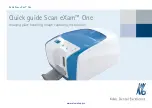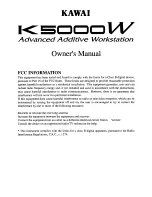
- personal protective equipment shall only be used by a person trained and competent in its safe use.
- a rescue plan shall be in place to deal with any emergencies that could arise during the work.
- it is forbidden to make any alterations or additions to the equipment without the manufacturer's prior written consent.
- any repair shall only be carried out by equipment manufacturer or his certified representative.
- personal protective equipment shall not be used outside its limitations, or for any purpose other than that for which it is
intended.
- before use ensure about the compatibility of items of equipment assembled into a fall arrest system.
- periodically check connecting and adjusting of the equipment components to avoid accidental loosening or disconnecting
of the components.
- it is forbidden to use combinations of items of equipment in which the safe function of any one item is affected by or
interferes with the safe function of another.
- before each use of personal protective equipment it is obligatory to carry out a pre-use check of the equipment, to ensure
that it is in a serviceable condition and operates correctly before it is used.
- personal protective equipment must be withdrawn from use immediately when any doubt arise about its condition for safe
use and not used again until confirmed in writing by equipment manufacturer or his representative after carried out the
detailed inspection.
- personal protective equipment must not be used by a person with medical condition that could affect thesafety of the
equipment user in normal and emergency use.
- personal protective equipment should be a personal issue item.
- during pre-use check it is necessary to inspect all elements of the equipment in respect of any damages, excessive wear,
corrosion, abrasion, cutting or incorrect acting, especially retractable fall arresters -cable or webbing, retractor and brake
proper acting, casing, energy absorber, connector;
- regular periodic inspections are the essential for equipment maintenance and the safety of the users which depends
upon
the continued efficiency and durability of the equipment.
- during periodic inspection it is necessary to check the legibility of the equipment marking.
- it is essential for the safety of the user that if the product is re-sold outside the original country of destination the reseller
shall provide instructions for use, for maintenance, for periodic examination and for repair in language of the country in
which the product is to be used.
- any doubt arise about its condition for safe use and not used again until confirmed in writing by equipment manufacturer
or
his representative after carried out the detailed inspection.
- a full body harness conformed to EN 361 is the only acceptable body holding device that can be used in a fall arrest
system.
- in full body harness use only attaching points marked with big letter "A" to attach a fall arrest system.
- the anchor device or anchor point for the fall arrest system should always be positioned, and the workcarried out in such
a
way, as to minimise both the potential for falls and potential fall distance. The anchor device/point should be placed above
the user . The shape and construction of the anchor device/point shall not allowed to self-acting disconnection of the
equipment. It is recommended to use certified and marked structural anchor point complied with EN 795.
THE ESSENTIAL PRINCIPLES OF USE OF PPE AGAINST FALLS FROM A HEIGHT
CONNECTING THE FALL ARRESTER TO FULL BODY HARNESS:
- the device must be connected only to frontal or dorsal attachment point of full body
harness. Full body harness must conform to EN 361.
- always protect the gate of the snap hook against accidental opening with locking gear.
USING DOUBLE VERSION:
- only one device must be connected at all time. Only during hook operations two devices may
be conected simultaneously. It is recomended
PRE-USE INSPECTION
Before each use, a person who is going to use the fall arrester, shall make a close visual examination of the retractor’s
elements: cover, snap hook, handle, working cable or webbing (entire length), must be carried out in respect of mechanical,
chemical and thermal defects. The user has to check the retractor functioning by dynamic pulling the working cable/webbing.
The cable/webbing should block and stops pulling out. After releasing the cable/webbing, the retractor should pull in the
cable/webbing. The examination must be carried out by the user of the device. In the case of any defect or doubt of correct
condition of the fall arrester, do not use it.
During use the fall arrester should be protected from a contact with oils, acids, solvents, basics, open fire, hot metal drops
and sharp edges. During working on the lattice constructions we should avoid interleaving the working webbigbetween the
individual construction elements. We should avoid using the device in the dust laden and greasy environment.
Using the fall arrest, in connection with fall arrest system, must be compatible with manual instructions of the systems
and obligatory standards:
- EN795 - for anchorages
- EN361 - for the safety harness
- EN362 - for the connectors
The fall arrester must be connected to structural anchor point using a
connector [A] or sling [B] complying with EN362 or EN795 standards.It is
forbidden to use the webbing of the device as the loop [C].
Structural anchorage point should have static resistance min.12kN.
The shape of the structural anchorage point should not let selfacting
disconnection of the device.Safety connector or fastening elements has
to be protected from lateral and bending forces. It is recommended to use
certified and marked structural anchorage point complied with EN 795.
When the device is installed in the vertical line above the user the minimal clearence
distance below working level shall be 1,5 m.
When the device is installed at the foot level [CNB/11.085] the minimal clearence distance
should be calculated as: CL=L+B+h+s (see ilustration [D]) where:
CL- clearance distansce
L- max. length of the device 1,8m
B- max. braking distance 1,2m
h - height of the user
s - safe distance ~1m
When connected to anchor device EN795 B/C see the instruction manual to determine the
additional strech of the system.
When the cable of the retractable fall arrester is deflected from vertical line a pendulum
effect occurs during fall arresting. Always try to limit the latteral distance from the anchor point.
CONNECTING THE FALL ARRESTER TO STRUCTURAL ANCHOR POINT
STRUCTURAL ANCHOR POINT REQUIRMENTS
Anchor point
D
L
L+B
h
s
Anchor point
o
max. 90
B
A
C
PERIODIC INSPECTIONS
The device must be inspected at least once every 12 months from the date of first use. Periodic inspections must
only be carried out by a competent person who has the knowledge and training required for personal protective
equipment periodic inspections. Depending upon the type and environment of work, inspections may be needed to
be carried out more frequently than once every 12 months. Every periodic inspection must be recorded in the Identity
Card of the equipment.
MAXIMUM LIFESPAN OF THE EQUIPMENT
The maximum lifespan of the device is 10 years from the date of manufacture. The device must be withdrawn from
use immediately and destroyed when it has been used to arrest a fall or it fails to pass inspection or there are any
doubt as to its reliability.
ATTENTION: The lifetime of the device depends on the intensity of usage and the environment of use. Using the
device in rough environment, marine environment, contact with sharp edges, exposure to extreme temperatures or
agressive substances, etc. can lead to the wthdrawal from use even after one use.




















